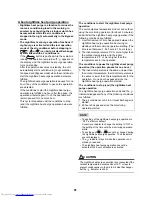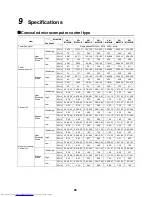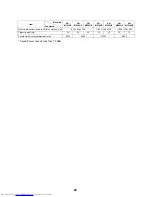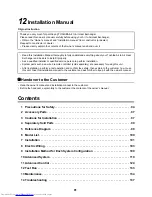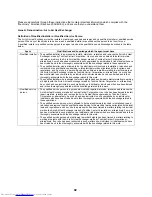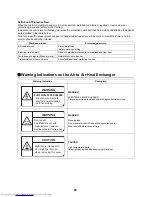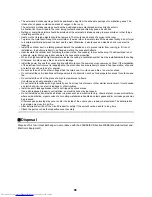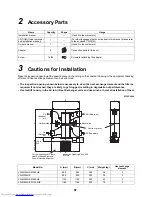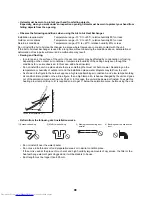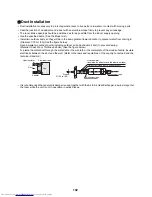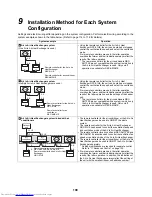
95
Electrical wiring
• Only a qualified installer(*1) or qualified service person(*1) is allowed to carry out the electrical work of the Air to Air
Heat Exchanger. Under no circumstances must this work be done by an unqualified individual since failure to carry
out the work properly may result in electric shocks and/or electrical leaks.
• When repairing the electrical parts or undertaking other electrical jobs, wear gloves to provide protection for
electricians and from heat. Failure to wear this protective gear may result in burn.
• Use wiring that meets the specifications in the Installation Manual and the stipulations in the local regulations and
laws. Use of wiring which does not meet the specifications may give rise to electric shocks, electrical leakage,
smoking and/or a fire.
• Connect earth wire. (Grounding work)
Incomplete earthing causes an electric shock.
• Do not connect earth wires to gas pipes, water pipes, and lightning rods or earth wires for telephone wires.
• After completing the repair or relocation work, check that the earth wires are connected properly.
• Install a circuit breaker that meets the specifications in the installation manual and the stipulations in the local
regulations and laws. Use an exclusive power supply circuit for the Air to Air Heat Exchanger at the rated voltage.
• Install the circuit breaker where it can be easily accessed by the agent.
• When installing the circuit breaker outdoors, install one which is designed to be used outdoors.
• Under no circumstances must the power cable be extended. Connection trouble in the places where the cable is
extended may give rise to smoking and/or a fire.
• Electrical wiring work shall be conducted according to law and regulation in the community and installation manual.
Failure to do so may result in electrocution or short circuit.
• When carrying out electric connection, use the wire specified in the Installation Manual and connect and fix the wires
securely to prevent them applying external force to the terminals. Improper connection or fixing may result in fire.
Test run
• Before operating the Air to Air Heat Exchanger after having completed the work, check that the electrical control cover
and inspection cover are closed, and set the circuit breaker to the ON position. You may receive an electric shock if
the power is turned on without first conducting these checks.
• When there is some kind of trouble (such as when an error display has appeared, there is a smell of burning,
abnormal sounds are heard, or water is leaking) has occurred in the Air to Air Heat Exchanger, do not touch the Air
to Air Heat Exchanger yourself but set the circuit breaker to the OFF position, and contact a qualified service person.
Take steps to ensure that the power will not be turned on (by marking “out of service” near the circuit breaker, for
instance) until qualified service person arrives. Continuing to use the Air to Air Heat Exchanger in the trouble status
may cause mechanical problems to escalate or result in electric shocks, etc.
• After the work has finished, use an insulation tester set (500V Megger) to check the resistance is 1 M
ȍ
or more
between the charge section and the non-charge metal section (Earth section). If the resistance value is low, a disaster
such as a leak or electric shock is caused at user’s side.
• Upon completion of the installation work, check the insulation resistance. Then conduct a test run to check that the
Air to Air Heat Exchanger is operating properly.
Explanations given to user
• Upon completion of the installation work, tell the user where the circuit breaker is located. If the user does not know
where the circuit breaker is, he or she will not be able to turn it off in the event that trouble has occurred in the Air to
Air Heat Exchanger.
• After the installation work, follow the Owner’s Manual to explain to the customer how to use and maintain the unit.
• If there is a danger of the Air to Air Heat Exchanger falling, do not approach the Air to Air Heat Exchanger but set the
circuit breaker to the OFF position, and contact a qualified service person(*1) to have the repairs done. Do not set
the circuit breaker to the ON position until the repairs are completed.
Relocation
• Only a qualified installer(*1) or qualified service person(*1) is allowed to relocate the Air to Air Heat Exchanger. It is
dangerous for the Air to Air Heat Exchanger to be relocated by an unqualified individual since a fire, electric shocks,
injury, water leakage, noise and/or vibration may result.
(*1) Refer to the “Definition of Qualified Installer or Qualified Service Person.”
CAUTION
To Disconnect the Appliance from Main Power Supply.
• Means for disconnection having a contact separation in all poles at least 3 mm must be incorporated in the fixed
wiring in accordance with the wiring rules.
The installation fuse (All Types Can Be Used) must be used for the power supply line of this Air to Air
Heat Exchanger.
Summary of Contents for VN-M1000HE
Page 150: ......

